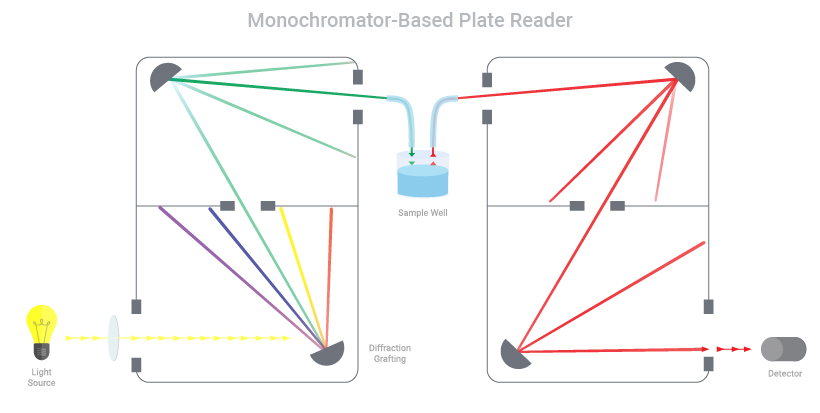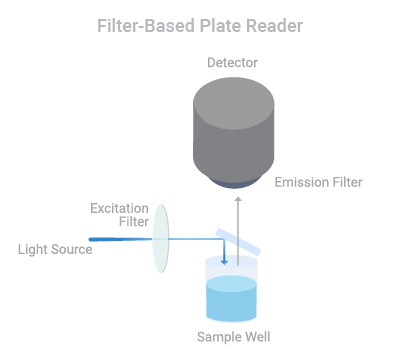When it comes to purchasing a microplate reader for fluorescence detection, the most common question is whether to choose a monochromator-based reader or filter-based reader. In this blog, we’ll discuss how both types of plate readers work and factors to consider when determining the best plate reader for your need.
How do monochromator-based plate readers work?
Monochromators work by taking a light source and splitting the light to focus a particular wavelength on the sample. During excitation, the light passes through a narrow slit, directed by a series of mirrors and diffraction grating and then passes through a second narrow slit prior to reaching the sample. This ensures the desired wavelength is selected to excite the fluorophore. Once the fluorophore is excited, it emits light at a different, longer wavelength. This emission light is captured by another series of mirrors, grating and slits to limit the emission to a desired wavelength, which then enters a detector for signal readout.

How do filter-based plate readers work?
A filter-based plate reader works by using optical filters to allow only a specific wavelength of light to pass through. First, the source light is filtered through an excitation filter that determines the excitation wavelength. The fluorophore then emits the light at a different wavelength selected by the emission filter, and the emitted fluorescence enters a detector for signal readout.

What to consider when choosing a plate reader
Convenience
Monochromator-based readers can measure wavelengths over a broad range. Having all wavelengths immediately available provides great flexibility in wavelength selection. Filter-based readers require a specialized filter for each wavelength. However, filters can be tailored to work with specific assays to achieve maximum performance.
Spectral Scanning
Monochromator-based readers allow you to scan an entire spectrum to characterize a sample, which is not possible with a filter-based reader. On the rare occasion that you are developing new fluorescent compounds in which the excitation and emission spectra are unknown, you would need a monochromator-based reader.
Sensitivity
If you need high sensitivity, a filter-based reader is the way to go. Monochromator-based readers are generally less sensitive because they only transmit a small fraction of light to the sample. When the monochromator selects a wavelength, most of the light from the source is lost, causing the excitation of the fluorophore to be significantly weaker. As the emitted light passes through a series of mirrors, grating and slits, light intensity is diminished even further. From the time the initial light source flashes until the specific wavelength of light finally reaches the detector, the loss of energy is compounded, which correlates with reduced sensitivity. For example, if the light energy is reduced 10-fold during the excitation process and another 10-fold is lost during the emission process, a total loss in assay sensitivity becomes 100-fold! This means you could miss a crucial result. In contrast, filter-based readers are much more efficient at delivering light to the sample, resulting in higher sensitivity.
Cost
Filter-based readers typically cost less than monochromator-based readers. This is partly because filter wheels are less expensive compared to monochromators. Monochromator instruments have many more components involved to achieve the wavelength selection and thus are more complicated mechanically. In addition, the light source of filter-based readers does not have to be as powerful since there is minimal loss of light.
Luminescence Detection
The efficient light transmission of filter-based readers allows them to detect a luminescence signal with high sensitivity, which cannot be achieved with monochromator-based readers. Filter-based readers would be the best choice if you plan on measuring luminescence (e.g., cell viability, protein:protein interaction or gene expression assays) in addition to fluorescence.
Wavelength Switch
Some assays require multiple wavelengths to be measured in a very short timeframe, such as multiplex assays that detect two different fluorescent wavelengths, or both fluorescence and luminescence signals. Filter-based readers work well with these assays because the filter wheels allow quick switching between two wavelengths—within a fraction of a second. The monochromator takes more time to switch wavelengths, and therefore cannot be used with these types of assays.
So…which is better?
Monochromator-based systems provide the ultimate flexibility in wavelength selection. However, the tradeoff is low sensitivity and high cost. Filter-based plate readers can also provide flexibility in selecting desired excitation and emission wavelengths by using customized filters sets across any desired wavelength of the optical detector. In general, a filter-based reader will provide more sensitive detection and can be used with luminescence or multiplex assays at a lower cost. For these reasons, unless you need to perform spectral scans, filter-based readers would be the preferred choice.
Interested in a filter-based plate reader with both assay sensitivity and user flexibility in mind? GloMax® plate readers are pre-loaded with a range of excitation and emission filter sets for the most common fluorophores. You can easily switch wavelengths across UV, Blue, Green and Red spectra, while achieving maximum assay sensitivity.
Learn more about our easy-to-use GloMax® plate readers with high sensitivity and broad dynamic range!
This blog was written in collaboration with Michael Bjerke, Sr. Product Manager, Promega Corporation
Related Posts
Latest posts by Johanna Lee (see all)
- Microfluidic Organoids Could Revolutionize Breast Cancer Treatment - March 25, 2025
- Bacteria From Insect Guts Could Help Degrade Plastic - January 28, 2025
- A Diabetes Drug, Metformin, Slows Aging in Male Monkeys - December 19, 2024
